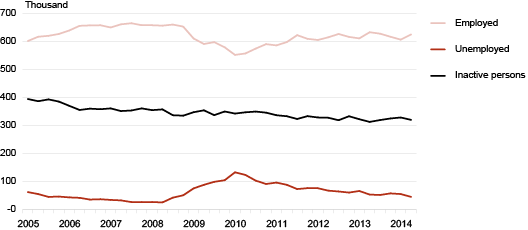Unemployment decreased in the 2nd quarter
According to the data of the Labour Force Survey, the estimated number of unemployed persons was 47,000 in the 2nd quarter, which is 10,000 less than in the previous quarter and 8,000 less than in the 2nd quarter of 2013. The unemployment rate was lower than both in the 1st quarter of this year and the 2nd quarter of 2013 (when the unemployment rate was 8.5% and 8.0%, respectively).
Unemployment decreased mainly due to the declining number of the short-term unemployed (i.e. people who had been looking for a job for less than a year) (compared to the 1st quarter, their number was down by 8,000). The number of the short-term and long-term unemployed was equal in the 2nd quarter (both numbered around 23,000 in the 2nd quarter). The number of the long-term unemployed (i.e. people who had been looking for a job for one year or longer) has been stable for the last four quarters; the long-term unemployment rate was 3.4% in the 2nd quarter.
Compared to the 1st quarter, as expected, the unemployment of men declined more and the employment of men increased more than that of women, as male employment is more influenced by seasonal factors. The unemployment rate of men was 7.5% and that of women 6.4% in the 2nd quarter.
The unemployment rate of persons aged 15–24 was 18.4% in the 2nd quarter and youth unemployment remained relatively stable compared to the 1st quarter. The young unemployed numbered 10,000 in total and the number was roughly the same both in the 1st quarter and in the same quarter a year earlier. The youth unemployment rate of persons aged 15–24 is calculated as a share of only those young people who are economically active (i.e. employed or unemployed), but most members of this age group are still studying. As a result, the share of the unemployed among all young people aged 15–24 was only 6.7%.
The estimated number of employed persons was 624,000, which was 19,000 persons more than in the previous quarter, but 8,000 persons less than in the same quarter of the previous year. While the quarterly increase was fostered by seasonal jobs, the yearly decline was influenced by diminishing working-age population (caused by negative net migration) and the increasing number of economically inactive persons, but also by the high comparison base of the 2nd quarter of 2013. The employment rate of the population aged 15–74 was 63.0% in the 2nd quarter. This is 1.9 percentage points higher than in the 1st quarter of this year (61.1%) and 0.2 percentage points lower than in the 2nd quarter of 2013 (63.2%). Compared to the previous quarter, the number of the employed increased twice as much for males than it did for females. By age groups, the employment of employees aged 50 and over increased the most, compared to the 1st quarter.
The increase in employment was most of all influenced by an increase in the number of persons employed in manufacturing, construction, wholesale and retail trade, and information and communication.
Economically inactive persons (students, retired persons, homemakers, discouraged persons, etc.) made up 32% (320,000 persons) among persons aged 15–74 in the 2nd quarter. Their number decreased by 9,000 compared the 1st quarter, influenced by seasonal growth of employment. Therefore, among inactive persons aged 15–74, the decrease occurred mainly in the number of persons inactive due to health issues (as a general trend, their number has nevertheless increased). There was a small decline in the number of discouraged persons (i.e. persons who have stopped seeking a job), they numbered 6,000 in the 2nd quarter.
Persons aged 15–74 by labour status, 1st quarter 2005 – 2nd quarter 2014
Unemployment rate is the share of the unemployed in the labour force (the sum of employed and unemployed persons). The long-term unemployment rate is the share of people who have been unemployed for a year or longer among the total labour force. The employment rate is the share of the employed in the working-age population (aged 15–74). The estimates are based on the data of the Labour Force Survey.
Statistics Estonia has been conducting the Labour Force Survey since 1995 and every quarter 5,000 persons participate in the survey. The Labour Force Survey is carried out by statistical organisations in all the European Union Member States on the basis of a harmonised methodology.
